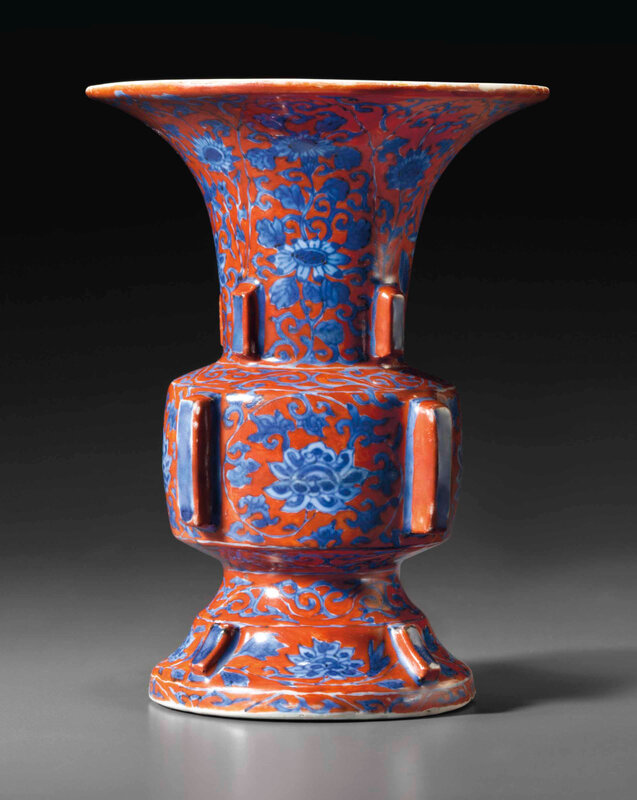A rare blue and white iron-red-ground archaistic vase, zun, Jiajing six-character mark and of the period (1522-1566)
Lot 3110. A rare blue and white iron-red-ground archaistic vase, zun, Jiajing six-character mark in underglaze blue within a double circle and of the period (1522-1566); 7 ½ in. (19 cm.) high. Estimate $80,000 – $120,000. Price realised USD 87,500. © Christie's Image Ltd 2015
The heavily potted, bronze-form vase is applied with rectangular flanges that accentuate its shape. The flanges on the neck separate four upright petals, each enclosing a different flowering stem including lotus, peony, hibiscus and chrysanthemum, and overlapping another row of flower-filled petals, while the flanges on the center section and spreading foot separate peony sprays bordered above and below by bands of classic scroll, all in shaded tones of underglaze blue against a rich iron-red ground, two Japanese wood boxes.
Note: The shape of this rare archaistic zun-shaped vase was one that found considerable favor with the Ming court, as evidenced by several blue and white examples of similar form dated to the Zhengde and Jiajing periods in the Palace Museum Collection, Beijing. Two of Zhengde date are illustrated in The Complete Collection of Treasures from the Palace Museum - 35 - Blue and White Porcelain with Underglazed Red (II), Hong Kong 2000, no. 50, decorated with winged dragons, and no. 51, decorated with peony scroll. Both of these vases also have plaintain leaves rising from the interior of the neck to the mouth rim, a motif not seen on the present vase. Also illustrated are two vases of zun shape of Jiajing date, no. 91, decorated with dragons on the body, tree peony on the neck and clouds on the foot, with a mid-section of similar shape to that of the present vase, and no. 92, decorated with fish swimming amidst lotus plants and water weeds against a wave ground. This latter vase is very similar to one sold at Christie's New York, 21 March 2013, lot 1456. Another vase of this shape, dated Chenghua, which is decorated with peony scroll supporting babao, was sold at Sotheby's Hong Kong, 8 April 2007, lot 523.
The particular shape of this vase, the curved flanges on the foot and the decoration, including the unusual decoration on the neck, which is not found on any of the above examples, appear to be directly based on cloisonné enamel zun-form prototypes of Xuande date, such as the example in the Avery Brundage Collection, Asian Art Museum of San Francisco, illustrated by B. Quette (ed.) in Cloisonné: Chinese Enamels from the Yuan, Ming and Qing Dynasties,New York, 2011, p. 82, fig. 5.2, and another sold at Christie's London, 11 May 2010, lot 119. (Fig. 1) As with the present vase, the flowers in the petal-shaped reserves on the neck of the Brundage vase all appear to be different, while those on the Christie's vase appear to be the same flower but in different colors. The rich iron-red ground of this vase is also very unusual, forming a unifying background for the somewhat dense underglaze blue decoration, and may have been inspired by the solid turquoise ground of the earlier cloisonné enamel vases.
Christie's. FINE CHINESE CERAMICS AND WORKS OF ART, 15 - 16 March 2015, New York, Rockefeller Plaza

/https%3A%2F%2Fprofilepics.canalblog.com%2Fprofilepics%2F1%2F0%2F100183.jpg)
/https%3A%2F%2Fstorage.canalblog.com%2F03%2F02%2F119589%2F96711876_o.jpg)
/https%3A%2F%2Fstorage.canalblog.com%2F11%2F31%2F119589%2F94773502_o.jpg)
/https%3A%2F%2Fstorage.canalblog.com%2F20%2F83%2F119589%2F94772815_o.jpg)
/https%3A%2F%2Fstorage.canalblog.com%2F26%2F72%2F119589%2F75604929_o.jpg)
/https%3A%2F%2Fstorage.canalblog.com%2F59%2F60%2F119589%2F26458628_o.jpg)



/http%3A%2F%2Fstorage.canalblog.com%2F04%2F42%2F119589%2F129831017_o.jpg)
/http%3A%2F%2Fstorage.canalblog.com%2F53%2F21%2F119589%2F129409104_o.jpg)
/http%3A%2F%2Fstorage.canalblog.com%2F79%2F64%2F119589%2F129153779_o.jpg)
/http%3A%2F%2Fstorage.canalblog.com%2F97%2F23%2F119589%2F128165935_o.jpg)